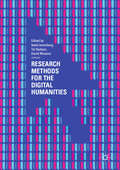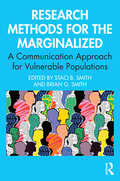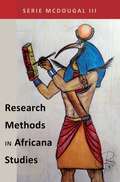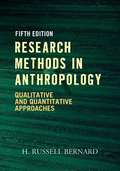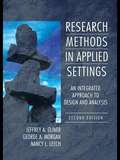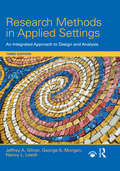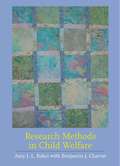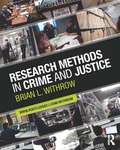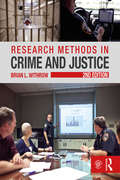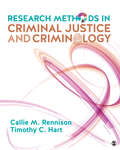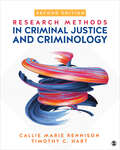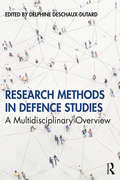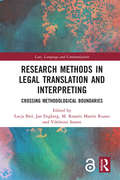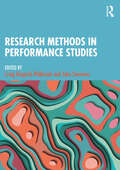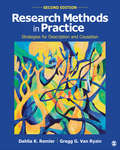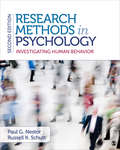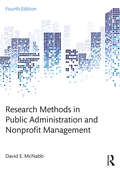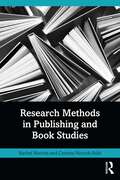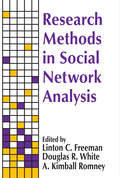- Table View
- List View
Research Methods for the Digital Humanities
by Lewis Levenberg Tai Neilson David RheamsThis volume introduces the reader to the wide range of methods that digital humanities employ, and offers a practical guide to the study, interpretation, and presentation of cultural material and practices. In this instance, the editors consider digital humanities to include both the use of computing to understand cultural material in new ways, and the application of theories and methods from the humanities to interpret new technologies. Each chapter provides a step-by-step guide to cutting-edge methodologies so that students can make informed decisions about the methods they use, consider ethical practices, follow practical procedures, and present their work effectively. Readers will develop practical and reflexive understandings of the software and digital devices that they study and use for research, and the book will help new researchers collaborate and contribute to their scholarly communities, and to public discourse. As contemporary humanities work becomes increasingly interdisciplinary, and increasingly permeated by and with digital technologies, this volume helps new researchers navigate an evolving academic environment. Humanities and social sciences students will find this textbook an invaluable resource for assessing and creating digital projects.
Research Methods for the Marginalized: A Communication Approach for Vulnerable Populations
by Brian G. Smith Staci B. SmithThis edited volume explores how to effectively and ethically conduct social science research and work with marginalized and vulnerable populations.Many researchers find themselves unprepared for the challenges of studying or working with populations that may be outside their personal expectations and experiences, affecting their ability to accurately represent the lived experiences of marginalized and vulnerable communities. Written by a diverse group of international scholars within the fields of strategic communication and communication studies, this volume provides real-world insights from researchers who not only have direct experience working with marginalized populations, but many of whom are members of these communities. Imperatives include critical lessons for access and accessibility in research. Contributors draw on their own studies to guide readers through the main phases of research, including study design, data collection, and data analysis.The volume is especially suited as a supplementary text for researchers and students studying qualitative research methods in strategic communication and communication studies.
Research Methods in Africana Studies
by Serie McDougalResearch Methods in Africana Studies is a major contribution to the discipline of Africana studies and social science involving people of African descent in general. This textbook is the first of its kind, offering instruction on how to conduct culturally relevant critical research on Africana communities in the American context, in addition to the African diaspora. It contains a collection of the most widely used theories and paradigms designed for exploring, explaining, and advancing Africana communities through science. The relevance, strengths, and weaknesses of every major method of data collection are explained as they relate to the lived experiences of the Black world. It stands alone as the only textbook that details empirical methods in the service of the collective advancement of Africana peoples.
Research Methods in Africana Studies
by Serie McDougal IIIThe revised edition of Research Methods in Africana Studies is a major contribution to the discipline of Africana studies and social science involving people of African descent in general. The first edition was the first of its kind, offering instruction on how to conduct culturally relevant critical research on Africana communities in the American context, in addition to the African diaspora. The revised edition contains a collection of the most widely used theories and paradigms designed for exploring, explaining, and advancing Africana communities through science. The relevance, strengths, and weaknesses of every major method of data collection are explained as they relate to the lived experiences of the Black world. It stands alone as the only textbook that details empirical methods in the service of the collective advancement of Africana peoples.
Research Methods in Anthropology: Qualitative and Quantitative Approaches (Reference, Information and Interdisciplinary Subjects)
by H. Russell BernardResearch Methods in Anthropology is the standard textbook for methods classes in anthropology. Written in Russ BernardOs unmistakable conversational style, his guide has launched tens of thousands of students into the fieldwork enterprise with a combination of rigorous methodology, wry humor, and commonsense advice. Whether you are coming from a scientific, interpretive, or applied anthropological tradition, you will learn field methods from the best guide in both qualitative and quantitative methods.
Research Methods in Applied Settings
by George A. Morgan Jeffrey A. Gliner Nancy L. LeechThrough its integrated approach to quantitative research methods, this text teaches readers how to plan, conduct, and write a research project and select and interpret data so they can become better consumers of research. This is not a statistics book--there are very few formulas. Rather, this book helps students master which statistic to use when and how to interpret the results. Organized around the steps one takes in conducting a research project, this book is ideal for applied programs and for those who want to analyze and evaluate research articles. Having taught in a variety of departments, the authors have a good grasp of the research problems faced by master's and doctoral students in diverse areas of the behavioral and social sciences. Text adopters applaud the book's clarity. Students are often confused by other texts' use of inconsistent terminology. To avoid this confusion, the authors present a semantically consistent picture that emphasizes five research approaches-- randomized experimental, quasi-experimental, comparative, associational, and descriptive. The authors then show how these approaches lead to three kinds of research designs which, in turn, lead to three groups of statistics with the same names. This consistent framework increases comprehension and the ability to apply the material. Numerous applied problems, annotated examples, and diagrams and tables further promote comprehension. Although the book emphasizes quantitative research, the value of qualitative research is introduced. This extensively revised edition features more than 50% new material including: A new chapter on the evidence-based approach that emphasizes the importance of reporting confidence intervals and effect sizes and the increased use of meta-analysis. An increased emphasis on evaluating research including an 8 step plan for evaluating research validity (Chs. 23 & 24) and its application to the 5 sample studies used throughout the book (Ch. 25). Lots of practical advice on planning a research project (Ch. 2), data collection and coding (Ch. 15), writing the research report (Ch. 27), questions to use in evaluating a research article (Appendix E) and creating APA tables and figures (Appendix F). A new chapter on non-experimental approaches/designs (Ch. 7) including qualitative research. Web resources for students including critical thinking problems with answers and a sample outline of a research proposal. An earlier and expanded introduction to measurement reliability and validity to further emphasize their differences and importance. An extensively revised chapter on measurement validity consistent with the latest APA/AERA/NCME standards. Fewer chapters on inferential statistics with an increased focus on how their selection is related to the design of the study and how to interpret the results using significance testing and effect sizes and confidence intervals. Instructor's Resources with Power Points, test questions, answers to the application questions, and more. Intended for graduate research or quantitative/experimental methods/design courses in psychology, education, human development and family studies, and other behavioral, social, business, and health sciences, independent sections and chapters can be read in many orders allowing for flexibility in assigning topics. Due to its practical approach, this book also appeals to researchers and clinicians. Prior exposure to statistics and research methods is recommended.
Research Methods in Applied Settings: An Integrated Approach to Design and Analysis, Third Edition
by George A. Morgan Jeffrey A. Gliner Nancy L. LeechThis text teaches readers how to plan, conduct, and write a research project and select and interpret data through its integrated approach to quantitative research methods. Although not a statistics book, students learn to master which technique to use when and how to analyze and interpret results, making them better consumers of research. Organized around the steps of conducting a research project, this book is ideal for those who need to analyze journal articles. With teaching experience in various departments, the authors know how to address the research problems faced by behavioral and social sciences students. Independent sections and chapters can be read in any order allowing for flexibility in assigning topics. Adopters applaud the book’s clarity and applied interdependent approach to research. The book emphasizes five research approaches: randomized experimental, quasi-experimental, comparative, associational, and descriptive. These five approaches lead to three kinds of research designs which lead to three groups of statistics with the same names. This consistent framework increases comprehension while avoiding confusion caused by inconsistent terminology. Numerous examples, diagrams, tables, key terms, key distinctions, summaries, applied problems, interpretation questions, and suggested readings further promote understanding. This extensively revised edition features: More examples from published research articles to help readers better understand the research process. New Research in the Real World boxes that highlight actual research projects from various disciplines. Defined key terms in the margins and interpretation questions that help readers review the material. More detailed explanations of key concepts including reliability, validity, estimation, ethical and bias concerns, data security and assumptions, power analysis , and multiple and logistic regression. New sections on mediation and moderation analysis to address the latest techniques. More coverage of quasi-experimental design and qualitative research to reflect changing practices. A new appendix on how to write about results using APA guidelines to help new researchers. Online resources available at www.routledge.com/9781138852976 that provide instructors with PowerPoints, test questions, critical thinking exercises, a conversion guide, and answers to all of the book’s problems and questions. Students will find learning objectives, annotated links to further readings and key concepts, and key terms with links to definitions. Intended for graduate research methods or design or quantitative/experimental research methods courses in psychology, education, human development, family studies, and other behavioral, social, and health sciences, some exposure to statistics and research methods is recommended.
Research Methods in Child Welfare
by Amy J. Baker Benjamin CharvatSocial service agencies are facing the same expectations in quality management and outcomes as private companies, compelling staff members and researchers to provide and interpret valid and useful research to stakeholders at all levels in the field. Child welfare agencies are particularly scrutinized. In this textbook, two highly experienced researchers offer the best techniques for conducting sound research in the field. Covering not only the methodological challenges but also the real-life constraints of research in child welfare settings, Amy J. L. Baker and Benjamin J. Charvat present a volume that can be used both for general research methods and as a practical guide for conducting research in the field of child welfare. Baker and Charvat devote an entire chapter to ethical issues involved in researching children and their families and the limits of confidentiality within this population. They weave a discussion of ethics throughout the book, and each chapter begins with a scenario that presents a question or problem to work through, enabling readers to fully grasp the methods in the context of a specific setting or area of concern. Special sections concentrate on the value of continuous quality-improvement activities, which enable the collection and analysis of data outside of the strictures of publishable research, and the implementation of program evaluations, which can be helpful in obtaining further research and programmatic funding.
Research Methods in Conflict Settings
by Dyan Mazurana Karen Jacobsen Lacey Andrews Gale Dyan Mazurana Karen JacobsenIncreasing numbers of researchers are now working in regions experiencing high levels of conflict or crisis, or among populations that have fled violent conflict to become refugees or internally displaced persons. Understanding these conflicts and their aftermath should be shaped not only by the victors and their elite companions but also by the local people whose daily lives become intertwined with the conflict - and it is this "view from below" that this volume's authors seek to share. Yet conducting rigorous research in these kinds of field contexts presents a range of ethical, methodological, logistical, and security challenges not usually confronted in non-conflict field contexts. This volume compiles a rich variety of lessons learned by experienced field researchers, many of whom have faced demanding situations characterized by violence, profound and well-grounded distrust, and social fragmentation. The authors' offer options, ideas, and techniques for studying the situations of people affected by conflict and, by focusing on ethical and security issues, seek ways to safeguard the interests and integrity of the research "subjects" and of the researchers and their teams.
Research Methods in Crime and Justice
by Brian L. WithrowThis fresh and innovative hybrid text/online material for undergraduate CJ RESEARCH METHODS uniquely addresses the fundamental teaching issue for this course: how to communicate and successfully teach students that their future success as criminal justice practitioners is linked to their acquisition of research skills. The author Brian Withrow, a former Texas State Trooper, widely published academic researcher, and teacher of the undergraduate methods course, consistently demonstrates how research skills aren't just essential to university academic researchers; they are essential to student success as criminal justice practitioners, and to all who want to succeed in an information economy. More than 80 short, sharply focused examples throughout the text rely on actual research that is conducted by, on behalf of, or relevant to criminal justice practitioners. The book engages students' interests like no other.The online materials provide a wide array of instructor support material, all written by the author, and also offer a unique feature, The Researcher's Notebook, which provides students (and their instructors) a series of structured exercises leading to the development and completion of a research question, conducting a literature review, and designing a research method that provides the data necessary to answer the research question - all with a minimal amount of instructor supervision. Cover images are courtesy of Lauren Withrow
Research Methods in Crime and Justice (Criminology and Justice Studies)
by Brian L. Withrow<p>Research Methods in Crime and Justice, 2nd Edition, is an innovative text/online hybrid for undergraduate Criminal Justice Research Methods courses. This material uniquely addresses the fundamental teaching issue for this course: how to show students that success as criminal justice practitioners is linked to their acquisition of research skills. Brian Withrow, a widely published academic researcher and former Texas State Trooper, developed this approach for his own undergraduate Research Methods class. He persuasively demonstrates that research skills aren’t just essential to university academic researchers but to successful criminal justice practitioners as well. <p>More than 80 short, sharply focused examples throughout the text rely on research that is conducted by, on behalf of, or relevant to criminal justice practitioners to engage students’ interest like no other text of its kind. Extensive web materials all written by the author provide an array of instructor support material, including a Researcher’s Notebook that provides students (and their instructors) with a series of structured exercises leading to the development of a valid research project. Withrow systematically walks students through defining a question, conducting a literature review, and designing a research method that provides the data necessary to answer the research question—all online, with minimal instructor supervision. <p>The second edition features expanded coverage of measurement, qualitative research methods, and evaluation research methods, as well as additional downloadable journal articles to ensure students begin to think critically about research and can read scholarly literature.</p>
Research Methods in Criminal Justice and Criminology
by Callie Marie Rennison Timothy Christopher HartResearch Methods in Criminal Justice and Criminology connects key concepts to real field research and practices using contemporary examples and recurring case studies that demonstrate how concepts relate to your life. Authors Callie M. Rennison and Timothy C. Hart introduce practical research strategies used in criminal justice to show you how a research question can become a policy that changes or influences criminal justice practices. The book’s student-driven approach addresses both the why and the how as it covers the research process and focuses on the practical application of data collection and analysis. By demonstrating the variety of ways research can be used and reinforcing the need to discern quality research, the book prepares you to become a critical consumer and ethical producer of research.
Research Methods in Criminal Justice and Criminology
by Callie Marie Rennison Timothy Christopher HartResearch Methods in Criminal Justice and Criminology connects key concepts to real field research and practices using contemporary examples and recurring case studies that demonstrate how concepts relate to your life. Authors Callie M. Rennison and Timothy C. Hart introduce practical research strategies used in criminal justice to show you how a research question can become a policy that changes or influences criminal justice practices. The book’s student-driven approach addresses both the why and the how as it covers the research process and focuses on the practical application of data collection and analysis. By demonstrating the variety of ways research can be used and reinforcing the need to discern quality research, the book prepares you to become a critical consumer and ethical producer of research.
Research Methods in Criminal Justice and Criminology
by Callie Marie Rennison Timothy Christopher HartResearch Methods in Criminal Justice and Criminology connects key concepts to real field research and practices using contemporary examples and recurring case studies throughout the book that demonstrate how concepts relate to students’ lives. Authors Callie M. Rennison and Timothy C. Hart introduce practical research strategies used in criminal justice to show students how a research question can become a policy that changes or influences criminal justice practices. The book’s student-driven approach addresses both the why and the how as it covers the research process and focuses on the practical application of data collection and analysis. By demonstrating the variety of ways research can be used and reinforcing the need to discern quality research, the book prepares students to become critical consumers and ethical producers of research. The Second Edition includes two new case studies woven throughout and new expert profiles to highlight contemporary topics.
Research Methods in Criminal Justice and Criminology
by Callie Marie Rennison Timothy Christopher HartResearch Methods in Criminal Justice and Criminology connects key concepts to real field research and practices using contemporary examples and recurring case studies throughout the book that demonstrate how concepts relate to students’ lives. Authors Callie M. Rennison and Timothy C. Hart introduce practical research strategies used in criminal justice to show students how a research question can become a policy that changes or influences criminal justice practices. The book’s student-driven approach addresses both the why and the how as it covers the research process and focuses on the practical application of data collection and analysis. By demonstrating the variety of ways research can be used and reinforcing the need to discern quality research, the book prepares students to become critical consumers and ethical producers of research. The Second Edition includes two new case studies woven throughout and new expert profiles to highlight contemporary topics.
Research Methods in Defence Studies: A Multidisciplinary Overview
by Delphine Deschaux-DutardThis textbook provides an overview of qualitive and quantitative methods used in different social sciences to investigate defence issues.Recently, defence issues have become of increasing interest to researchers in the social sciences, but they raise specific methodological questions. This volume intends to fill a gap in the literature on defence studies by addressing a number of topics not dealt with sufficiently before. The contributors offer a range of methodological reflections and tools from various social sciences (political science, sociology, geography, history, economics and public law) for researching defence issues. They also address the increasingly important question of data and digitalization. The book introduces the added value of quantitative and qualitative methods, and calls for a cross-fertilization of methods in order to facilitate better research on defence topics and to fully grasp the complexity of defence in the 21st century.This book will be of much interest to students, researchers and practitioners of defence studies, war studies, military studies, and social science research methods in general.
Research Methods in Legal Translation and Interpreting: Crossing Methodological Boundaries (Law, Language and Communication)
by Łucja Biel Vilelmini Sosoni Jan Engberg Rosario Martín RuanoThe field of legal translation and interpreting has strongly expanded over recent years. As it has developed into an independent branch of Translation Studies, this book advocates for a substantiated discussion of methods and methodology, as well as knowledge about the variety of approaches actually applied in the field. It is argued that, complex and multifaceted as it is, legal translation calls for research that might cross boundaries across research approaches and disciplines in order to shed light on the many facets of this social practice. The volume addresses the challenge of methodological consolidation, triangulation and refinement. The work presents examples of the variety of theoretical approaches which have been developed in the discipline and of the methodological sophistication which is currently being called for. In this regard, by combining different perspectives, they expand our understanding of the roles played by legal translators and interpreters, who emerge as linguistic and intercultural mediators dealing with a rich variety of legal texts; as knowledge communicators and as builders of specialised knowledge; as social agents performing a socially situated activity; as decision-makers and agents subject to and redefining power relations, and as political actors shaping legal cultures and negotiating cultural identities, as well as their own professional identity.
Research Methods in Performance Studies
by Craig Gingrich-Philbrook Jake SimmonsResearch Methods in Performance Studies offers a unique approach for readers to engage with performance research and methods in practice. It examines ways of making performance, researching performance cultures, researching performers who themselves are engaged in research, and conducting research in the context of enduring and emergent themes of performance studies inquiry. This book features the work of eighteen scholar-artists currently working in performance studies who demonstrate—through applied projects—various methods for conducting performance research. The result is a wide array of novel scholarship including activist performance, slam poetry, video performance, stand-up comedy, adaptation for the Broadway stage, naturecultural performance, intersectional performance, performances of cultural and material preservation, and many others. Faculty, undergraduate and graduate students, and performance practitioners alike will benefit from the approaches to performance studies research methods articulated by the scholar-artists featured in this collection.
Research Methods in Practice: Strategies for Description and Causation
by Dahlia K. Remler Gregg G. Van RyzinThe Second Edition of Research Methods in Practice: Strategies for Description and Causation sets an entirely new standard for presenting and learning research methods. The perspective gained from this text makes it a truly necessary tool for such applied disciplines as public affairs and administration, public policy, psychology, urban affairs, education, sociology, social work, business, public health, political science, economics, communications and criminal justice. Imbued with a deep commitment to make social and policy research methods accessible and meaningful, the Second Edition of Research Methods in Practice: Strategies for Description and Causation compels and inspires students to truly grasp the logic—and limits—of the latest research appearing in academic journals, government reports, and the media. Authors Dahlia K. Remler and Gregg G. Van Ryzin cover the most pertinent issues and methods, emphasizing the critical interpretation and practical application of research findings. Both causation and description—and the distinction between them—are emphasized and maintained thematically throughout the text. Concepts are taught through in-depth examples, such as “Fighting Malaria in Kenya,” “The U.S. Poverty Measure,” “The Fallout from Hurricane Katrina,” “Family Dinners and Teenage Substance Abuse,” and “The Effect of Poverty on Mental Health.” The realistic trade-offs, uncertainties, habits, and excitement of the research experience come through on every page. “This is the best text available for teaching students the fundamentals of research design and statistics, and for introducing them to the difficulties inherent in evaluation research and causal inference.” —Dave E. Marcotte, University of Maryland, Baltimore County
Research Methods in Practice: Strategies for Description and Causation
by Dahlia K. Remler Gregg G. Van RyzinThoroughly updated to reflect changes in both research and methods, this Third Edition of Remler and Van Ryzin’s innovative, standard-setting text is imbued with a deep commitment to making social and policy research methods accessible and meaningful. Research Methods in Practice: Strategies for Description and Causation motivates readers to examine the logic and limits of social science research from academic journals and government reports. A central theme of causation versus description runs through the text, emphasizing the idea that causal research is essential to understanding the origins of social problems and their potential solutions. Readers will find excitement in the research experience as the best hope for improving the world in which we live, while also acknowledging the trade-offs and uncertainties in real-world research.
Research Methods in Practice: Strategies for Description and Causation
by Dahlia K. Remler Gregg G. Van RyzinThoroughly updated to reflect changes in both research and methods, this Third Edition of Remler and Van Ryzin’s innovative, standard-setting text is imbued with a deep commitment to making social and policy research methods accessible and meaningful. Research Methods in Practice: Strategies for Description and Causation motivates readers to examine the logic and limits of social science research from academic journals and government reports. A central theme of causation versus description runs through the text, emphasizing the idea that causal research is essential to understanding the origins of social problems and their potential solutions. Readers will find excitement in the research experience as the best hope for improving the world in which we live, while also acknowledging the trade-offs and uncertainties in real-world research.
Research Methods in Psychology: Investigating Human Behavior
by Russell K. Schutt Paul G. NestorThe Second Edition of Paul G. Nestor and Russell K. Schutt’s successful and unique Research Methods in Psychology: Investigating Human Behavior draws from substantive research stories to illustrate how research is presented while systematically unifying the entire research process within a conceptual framework. This accessible text examines engaging research studies and examples, considering research ethics throughout. “This is a great text that emphasizes the important concepts within research methods. The resources are excellent; they incorporate up-to-date research and technology and introduce the student to empirical articles, and the information is presented in a way that challenges the student to apply the material.” —Maria Pacella, Kent State University “The text is comprehensive. It covers a wide variety of information without being overwhelming. This is a very good textbook for an introductory course in research methods. I like that its focus is on psychological research specifically.” —Angela M. Heads, Prairie View A&M University
Research Methods in Public Administration and Nonprofit Management
by David E. McNabbNow in a thoroughly revised and refreshed fourth edition, Research Methods in Public Administration and Nonprofit Management is beloved by students and professors alike for its exceptional clarity and accessibility and plentiful illustrations. This new edition integrates quantitative, qualitative, and mixed-methods approaches, as well as specific up-to-date instruction in the use of statistical software programs such as Excel and SPSS. Changes to this edition include: A new section, featuring two new chapters, to explore mixed-methods approaches to research, including fundamentals, research design, data collection, and analyzing and interpreting findings A new, dedicated chapter on Big Data research Updated exhibits and examples throughout the book A new companion website to accompany the book containing PowerPoint slides for each chapter New exhibits, tables, figures, and exercises, as well as key terms and discussion questions at the end of each chapter Research Methods in Public Administration and Nonprofit Management, 4e is an ideal textbook for use in all research methods courses in undergraduate and graduate public administration, public affairs, and nonprofit management courses.
Research Methods in Publishing and Book Studies
by Corinna Norrick-Rühl Rachel NoordaEstablishing the unique opportunities and characteristics of doing research in publishing and book studies, this book demonstrates and evaluates the range of research methods that are available to students when conducting research within the field.Organized into three main parts, prefaced by a general introduction to the discipline, Research Methods in Publishing and Book Studies considers qualitative and quantitative methods and methods of data analysis in turn. Each chapter within these sections features: Details and logistics of the research method, including specific ethical considerations, disciplinary history, and distinguishing features when compared to other methods. Advantages and disadvantages of the method, helping students evaluate and choose the right method for their research. A case study of the Method in Action, written by featured authors with expertise in that area. Study questions to help readers test and solidify their knowledge. Further reading suggestions. By the end of the book, students will have a sound understanding of the methods commonly used in book and publishing studies and will be able to confidently identify and select methods for their own research projects and dissertations.This book is an essential resource for advanced undergraduate and postgraduate students and researchers in book and publishing studies.
Research Methods in Social Network Analysis
by A. Kimball Romney Linton C. Freeman Douglas R. WhiteSince the publication of Herbert Spencer's Principles of Sociology in 1875, the use of social structure as a defining concept has produced a large body of creative speculations, insights, and intuitions about social life. However, writers in this tradition do not always provide the sorts of formal definitons and propositions that are the building blocks of modern social research. In its broad-ranging examination of the kind of data that form the basis for the systematic study of social structure, Research Methods in Social Network Analysis marks a significant methodological advance in network studies.As used in this volume, social structure refers to a bundle of intuitive natural language ideas and concepts about patterning in social relationships among people. In contrast, social networks is used to refer to a collection of precise analytic and methodological concepts and procedures that facilitate the collection of data and the systematic study of such patterning. Accordingly, the book's five sections are arranged to address analytical problems in a series of logically ordered stages or processes.The major contributors define the fundamental modes by which social structural phenomena are to be represented; how boundaries to a social structure are set; how the relations of a network are measured in terms of structure and content; the ways in which the relational structure of a network affects system actors; and how actors within a social network are clustered into cliques or groups. The chapters in the last section build on solutions to problems proposed in the previous sections. This highly unified approach to research design combined with a representative diversity of viewpoints makes Research Methods in Social Network Analysis a state-of-the-art volume.
